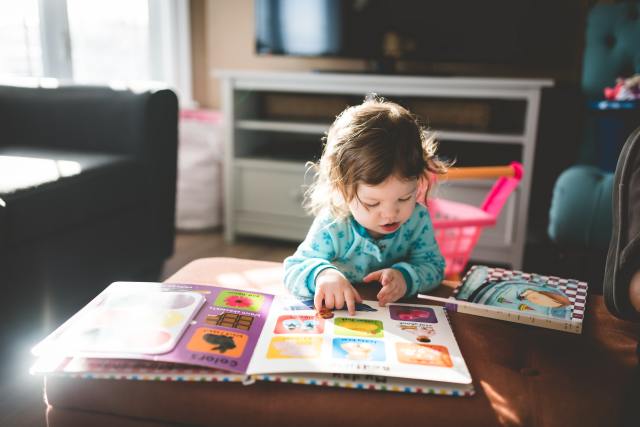Your child may not have any words yet, but they find ways to get their point across. While furious sobbing or tossing a bowl of applesauce may not be your preferred form of communication, trust me, these are good signs! When your child cries, gestures, or uses a facial expression, they’re expressing something: hunger, discomfort, frustration. They’re using nonverbal language, and that’s a stepping stone to speech.
Even before saying their first word, children make connections between their actions and getting their needs met. When your child cries and points to a toy, then you hand it to them, they’re figuring out these relationships so they can more easily communicate their needs later.
So never fear—at some point, your child will be able to express their wants more clearly than with screeching or tears. And as their caregiver, there’s a lot you can do to help that process along. Nurturing your child’s language development is time well spent. Not only does it help your child communicate, but it also supports literacy and comprehension, ultimately improving their academic success along with their emotional development.
Now for the best news: To help your toddler develop their language skills, the name of the game is play. Here are six fun and interactive playtime ideas to try at home. None of these is hard to build into your routine—and chances are, you’re doing some of them already.
1. Turn your home into a zoo—a noisy one.
Who doesn’t love animal sounds? They’re a perfect way to help your kiddo become more verbal. That’s because imitating sounds is a stepping stone to imitating words, and most kids get a kick out of meowing and mooing. To practice, gather up any toy animals you have. Or you can cut out pictures of animals from magazines or find some online to print out. Take turns showing these toys or pictures to your child and either making the sounds yourself or having your child mimic them.
If you’re feeling really creative, act out the animals as well. You can turn your hands into claws and “meow” like a cat or get on all fours and say “baaah” like a sheep. Encourage your child to copy you! One reason imitation is so important is that it teaches your baby the back-and-forth of communication, which is a foundation for early conversational skills.
Related: 7 Phrases to Avoid Saying to Your Toddler
2. Sing lots of songs (actual musical talent not required).
“Old MacDonald Had a Farm,” “Itsy, Bitsy Spider,” and “The Wheels on the Bus” are classics for a reason. Children love singing simple songs and nursery rhymes. Not only do they provide some great bonding time, but songs can also build vocabulary and help children learn and recognize the natural rhythm of speech.
There are lots of opportunities throughout the day to liven things up with music: Think car rides, chore time, bathtime, or waiting in line. And nursery rhymes that include hand gestures are another great way to teach your child imitation.
3. Get theatrical with a puppet show.
Inject some drama into your day with good old-fashioned puppets. Whether you’re using socks, brown lunch bags, or stuffed animals, it’s a great way to strike up a mock conversation between two lovable characters. Make sure your puppet asks your child’s puppet all sorts of questions (using silly and imaginative voices, of course).
4. Play a game of telephone.
And we don’t mean scrolling social media. For this, you can use a toy telephone, create one out of LEGOs or cardboard, or even use an old cellphone if you have one. Pretend that the phone is ringing and have your child “answer.” Whether they’re babbling into the receiver or using simple words like “hi” and “bye,” this activity helps set the stage for early conversation skills.
5. Make time for storytime.
You’ve probably heard it before, but it’s hard to overstate the importance of reading, even with babies and toddlers. Children start building the foundation for reading and writing in infancy. So when you establish a reading routine, you’re creating a good habit that will last a lifetime. Make storytime fun by choosing books that stimulate the imagination.
As you read, make sure to point to and label the pictures. If the page shows, say, a firetruck, you can engage your toddler by asking, “What sound does a firetruck make?” This will improve your child’s comprehension and expand their vocabulary.
Related: 40 of the Very Best Books for Toddlers
6. Turn “I Spy” into “I Hear.”
Choose a few everyday items that your child is familiar with—a toy, a banana, a cup, a spoon—and place them on the table. Next, say to your child, “I spy something that starts with ‘bbbbb.’” Really exaggerate your sounds and give your child enough time to find the correct item—in this case, a banana.
Provide encouragement and a little assistance if needed, and if your child gets it right, pour on the praise! This game expands your child’s vocabulary and helps them make associations between sounds, words, and objects.
What if your child’s language doesn’t seem to develop at the rate you expect? Consider speaking with a speech-language pathologist. These communication experts can work with you and your child to evaluate, diagnose, and treat a potential language disorder or other communication challenge.
The earlier these issues are recognized and treated, the more progress your child will make. Make sure, too, that your speech therapist gives you additional language-building exercises to use at home with your child. When it comes down to it, you are your child’s best communication model.











